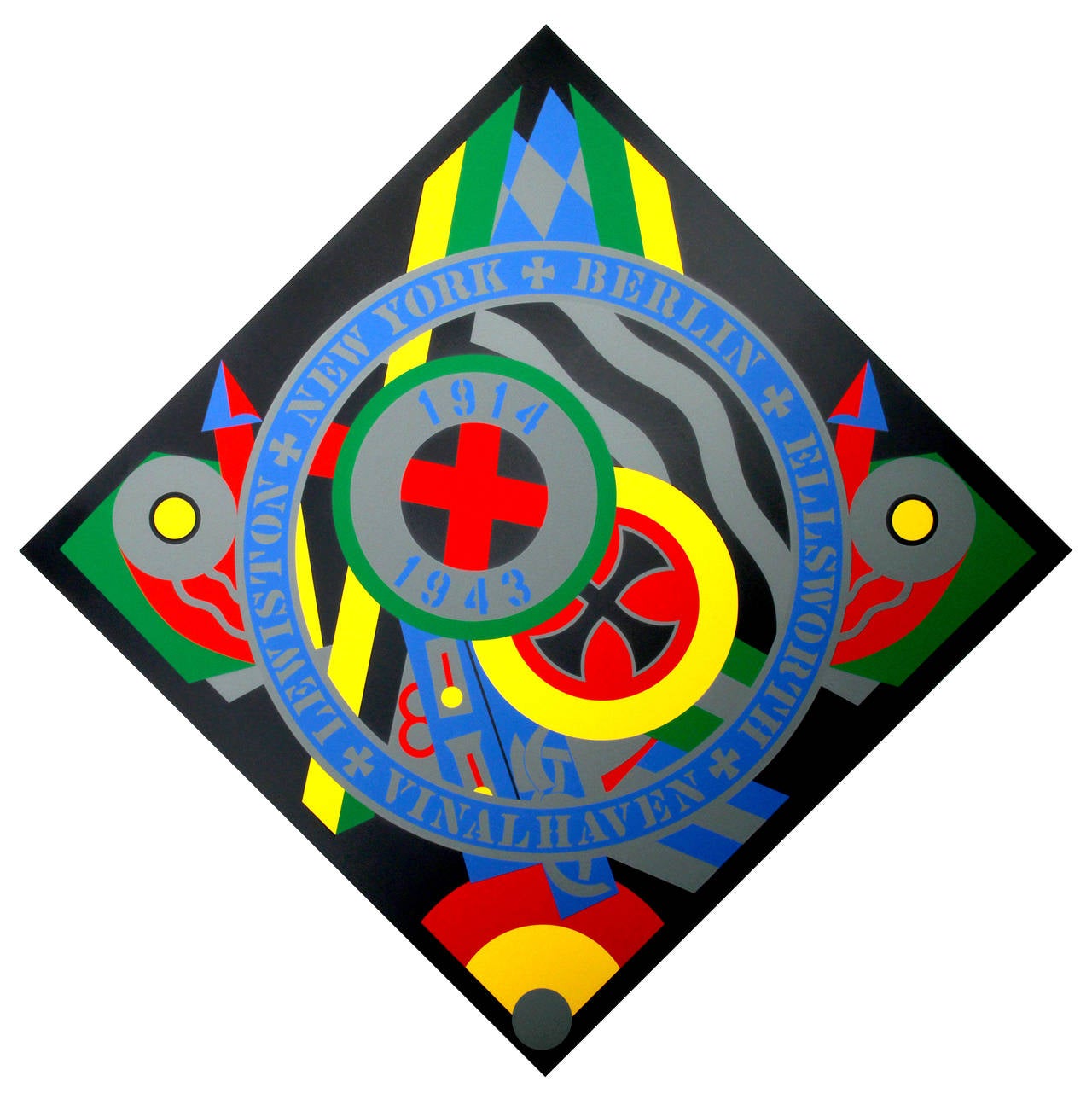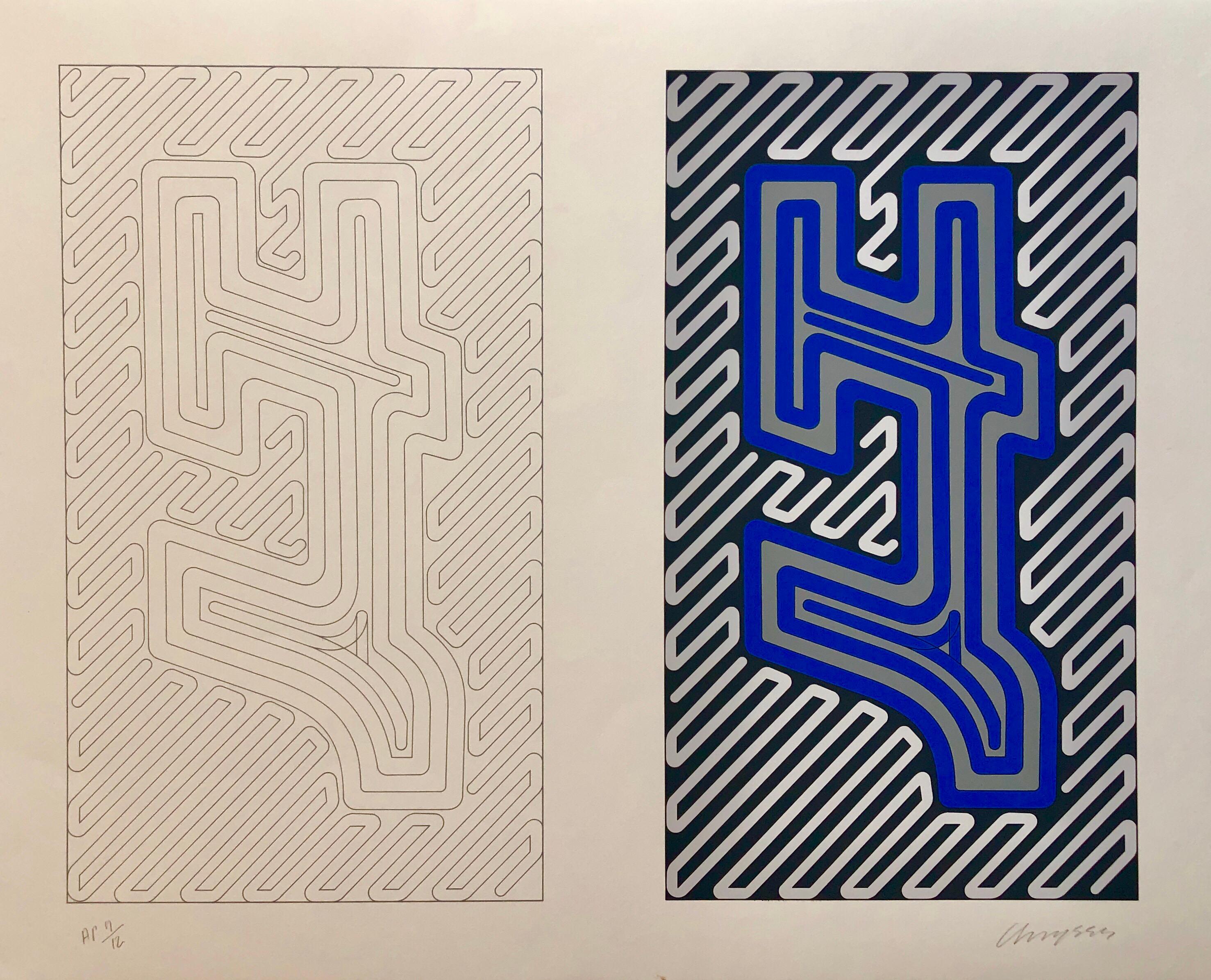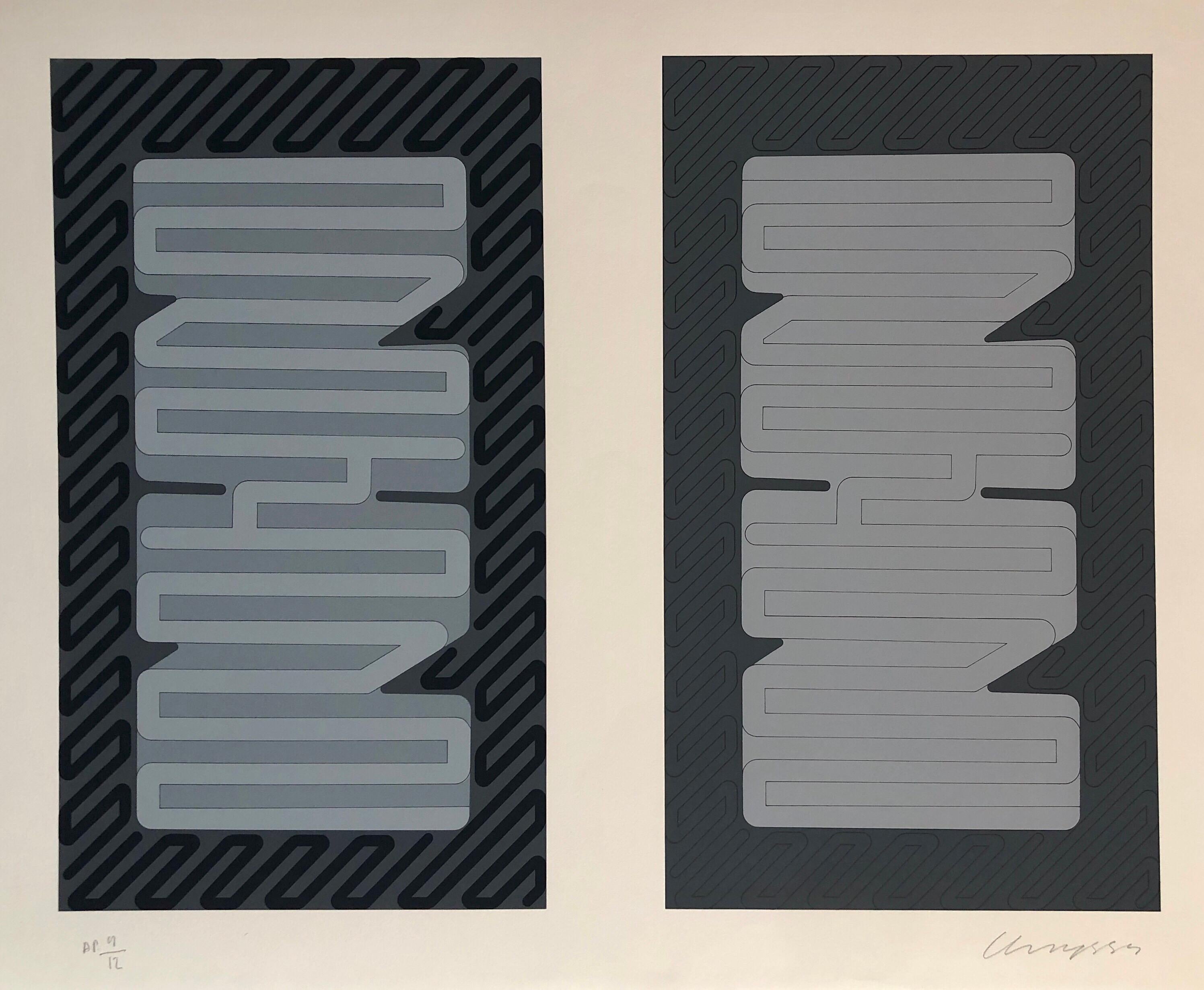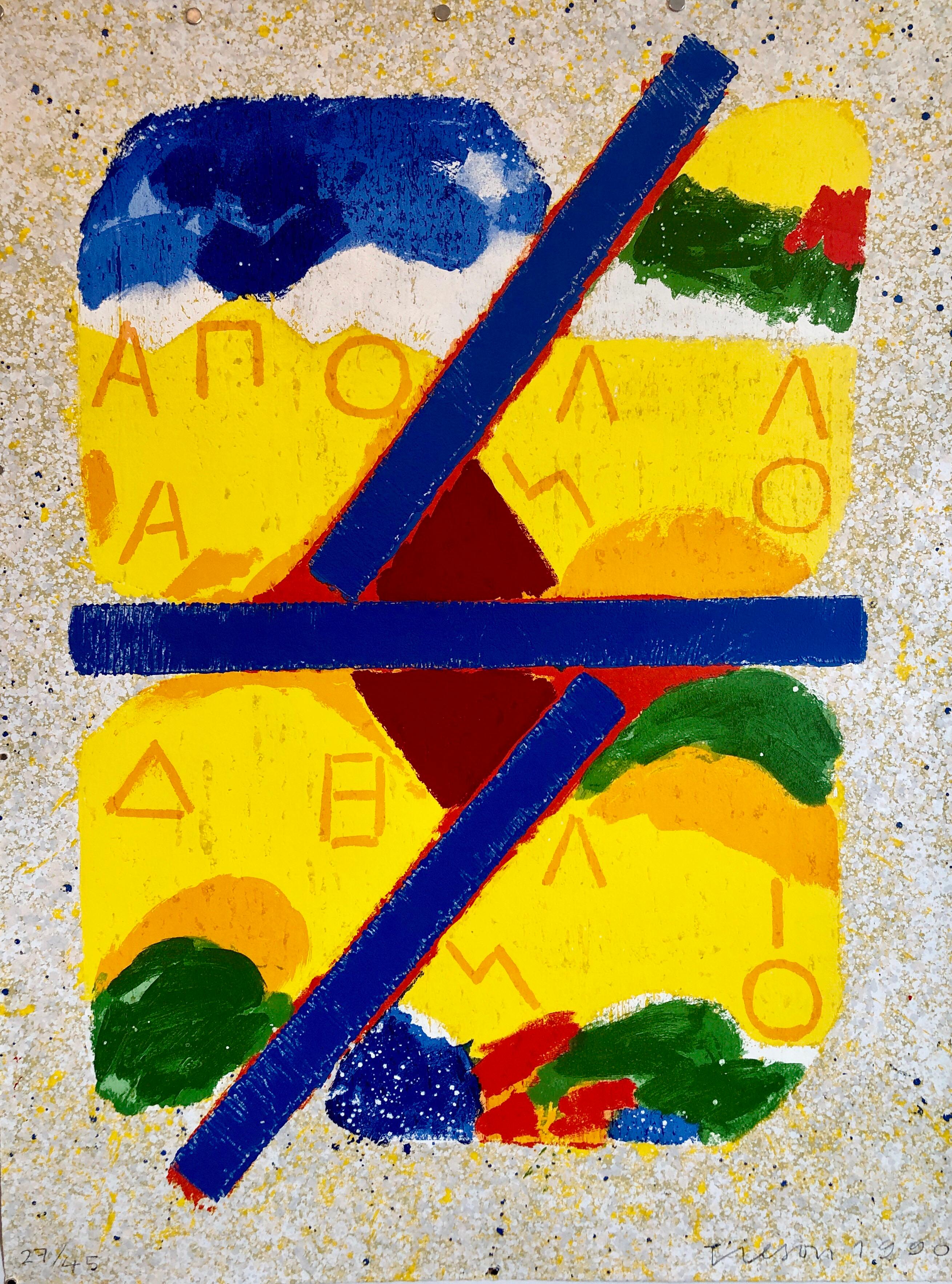Items Similar to Epitaph/Tombstone jack Armstrong Pop Art 1969 Color Screenprint Richard Merkin
Want more images or videos?
Request additional images or videos from the seller
1 of 8
Richard MerkinEpitaph/Tombstone jack Armstrong Pop Art 1969 Color Screenprint Richard Merkin
About the Item
Poetry by J.D. REED Artwork by Richard Merkin screenprint in color, 1969, edition 22/50 Published by Bizzaro, Providence, R.I.
Richard Marshall Merkin (1938-2009) was an American painter, illustrator and arts educator. Merkin's fascination with the 1920s and 1930s defined his art and shaped his identity as a professional dandy. Merkin traveled back in time as an artist, to the time of the interwar years, creating narrative scenes (ala Robert Crumb and Ben Katchor) in bright colors of jazz musicians, film stars, writers, and sports heroes. Merkin was as well known for his painting and illustration work as he was for his eccentric collecting habits and his outré fashion sense. he received a Louis Comfort Tiffany Foundation Fellowship in Painting.
Merkin began teaching at the Rhode Island School of Design (RISD) in 1963 and remained there for 42 years, during which time he built his reputation in New York. Some notable students Merkin taught at RISD include Chris Frantz and Tina Weymouth of the band Talking Heads and Martin Mull.
Merkin had been a contributing editor for Vanity Fair since 1986 and a regular contributor of illustrations to The New Yorker since 1988, as well as Harper's and The New York Times' Sunday Magazine. From 1988–1991, he wrote a monthly style column called "Merkin on Style" for Gentlemen's Quarterly.
Merkin also designed several album covers for the Jazz record label Chiaroscuro Records for artists such as Mary Lou Williams, Ruby Braff, and Ellis Larkins.
Merkin's friend, the writer Tom Wolfe wrote in an email to the New York Times upon Merkin's death:
"He was the greatest of that breed, the Artist Dandy, since Sargent, Whistler and Salvador Dali, Like Dali, he had one of the few remaining Great Mustaches in the art world" Perpetually on the fly from his middle-class Brooklyn background, Merkin found the perfect escape in the mid ‘60s in George Frazier, a dapper Boston columnist who inspired the emerging New York painter’s overnight reinvention of himself. The elements of structure, stability and surprise he admired in this well-dressed dandy, a cool linen suit, a splash of suspender, a polka dot scarf and pearl-handled walking stick, soon surfaced in paintings peopled by impeccable underdogs of café society along with his personal pop heroes, William Burroughs, Bobby Short and Krazy Kat. He was also a friend of the novelist Tom Wolfe and was influenced by the artist R.B. Kitaj. He has exhibited in countless gallery and museum shows in the US and abroad and is represented in the permanent collections of the Smithsonian Institution, The Museum of Modern Art, the Whitney Museum, the RISD museum and many others. In addition to contributing drawings and paintings to The New Yorker (along with, Art Spiegelman, Saul Steinberg, Harper’s, The New York Times Sunday Magazine and several books on Erotica and Baseball, he is a contributing editor for Vanity Fair and a former style columnist for GQ. Merkin’s honors include a Tiffany Foundation Fellowship and the Rosenthal Foundation Award from the American Academy of Arts and Letters.
Museums and Selected Collections :
The American Federation of Arts, New York, NY
Brooklyn Museum, Brooklyn, NY
Chrysler Museum of Art, Norfolk, VA
Massachusetts Institute of Technology, Cambridge, MA
Minnesota Museum of Art, Minneapolis, MN
Museum of Modern Art, New York, NY
Museum of Art, Rhode Island School of Design, RI
Pennsylvania Academy of the Arts, Philadelphia PA
Prudential Insurance Company, Boston, Ma
Prudential Insurance Company, Newark, NJ
Rose Art Museum, Brandeis University, Waltham, MA
Smithsonian Institution, Washington, DC
Whitney Museum of American Art, New York, NY
Selected Publications :
1986-Present Contributing Editor, Vanity Fair. 1988-Present, New Yorker. 1988-Present, style column, GQ 1997, Text and Illustration for The Tijuana Bibles, published by Simon & Shuster, 1995, Illustrated book, Leagues Apart: the Men and Times of the Negro Baseball Leagues published by Morrow.
1967 Cover of the Beatles “Sgt. Peppers Lonely Hearts Club Band” Album (Mr. Merkin appears in the back row, right of center)
- Creator:Richard Merkin (1938 - 2009, American)
- Dimensions:Height: 26 in (66.04 cm)Width: 20 in (50.8 cm)
- Medium:
- Movement & Style:
- Period:
- Condition:
- Gallery Location:Surfside, FL
- Reference Number:1stDibs: LU38211138662
Richard Merkin
Richard Merkin’s (1938 – September 5, 2009) work conjures up scenes that evoke the raucous spirit of the 1920’s, 30’s and 40’s. In his witty, often eccentric illustrations, Merkin depicts movie stars, jazz musicians, sports heroes and literary impresarios co-mingling with more personal references. In his highly stylized approach to the figure, Merkin privileges color relationships, balance and juxtaposition over strictly literal descriptions of his subjects. And humor; there’s always humor.
About the Seller
4.9
Platinum Seller
These expertly vetted sellers are 1stDibs' most experienced sellers and are rated highest by our customers.
Established in 1995
1stDibs seller since 2014
1,560 sales on 1stDibs
Typical response time: 1 hour
- ShippingRetrieving quote...Ships From: Surfside, FL
- Return PolicyA return for this item may be initiated within 3 days of delivery.
More From This SellerView All
- 1970's Large Silkscreen Abstract Geometric Day Glo Serigraph Pop Art Print NeonBy Chryssa Vardea-MavromichaliLocated in Surfside, FLSilkscreen on Arches paper, Hand signed and Numbered in Pencil. Serigraph in blue gray (silver). Chryssa Vardea-Mavromichali (Greek: Χρύσα Βαρδέα-Μαυρομιχάλη; December 31, 1933 – December 23, 2013) was a Greek American artist who worked in a wide variety of media. An American art pioneer in light art and luminist sculpture widely known for her neon, steel, aluminum and acrylic glass installations, she has always used the mononym Chryssa professionally. She worked from the mid-1950s in New York City studios and worked since 1992 in the studio she established in Neos Kosmos, Athens, Greece. Chryssa was born in Athens into the famous Mavromichalis family from the Mani Peninsula. one of her sisters, who studied medicine, was a friend of the poet and novelist Nikos Kazantzakis. Chryssa began painting during her teenage years and also studied to be a social worker.In 1953, on the advice of a Greek art critic, her family sent her to Paris to study at the Académie de la Grande Chaumiere where Andre Breton, Edgard Varese, and Max Ernst were among her associates and Alberto Giacometti was a visiting professor. In 1954, at age twenty-one, Chryssa sailed for the United States, arrived in New York and went to San Francisco, California to study at the California School of Fine Arts. Returning to New York in 1955, she became a United States citizen and established a studio in the city. Chryssa's first major work was The Cycladic Books preceded American minimalism by seventeen years. 1961, Chryssa's first solo exhibition was mounted at The Guggenheim. 1963, Chryssa's work was shown at the Museum of Modern Art in curator Dorothy Canning Miller's Americans 1963 exhibition. The artists represented in the show also included Richard Anuszkiewicz, Lee Bontecou, Robert Indiana, Richard Lindner, Marisol, Claes Oldenburg, Ad Reinhardt, James Rosenquist and others. 1966, The Gates to Times Square, regarded as "one of the most important American sculptures of all time" and "a thrilling homage to the living American culture of advertising and mass communications." The work is a 10 ft cube installation of two huge letter 'A's through which visitors may walk into "a gleaming block of stainless steel and Plexiglas that seems to quiver in the play of pale blue neon light" which is controlled by programmed timers. First shown in Manhattan's Pace Gallery, it was given to the Albright-Knox Art Gallery in Buffalo, New York in 1972. 1972, The Whitney Museum of American Art mounted a solo exhibition of works by Chryssa. That's All (early 1970s), the central panel of a triptych related to The Gates of Times Square, was acquired by the Museum of Modern Art between 1975 and 1979. 1973, Chryssa's solo exhibition at the Gallerie Denise René was reviewed for TIME magazine by art critic Robert Hughes before it went on to the Galleries Denise René in Düsseldorf and Paris. Other works by Chryssa in composite honeycomb aluminum and neon in the 1980s and 1990s include Chinatown, Siren, Urban Traffic, and Flapping Birds. Chryssa 60/90 retrospective exhibition in Athens in the Mihalarias Art Center. After her long absence from Greece, a major exhibition including large aluminum sculptures - cityscapes, "neon boxes" from the Gates to the Times Square, paintings, drawings etc. was held in Athens. In 1992, after closing her SoHo studio, which art dealer Leo Castelli had described as "one of the loveliest in the world," Chryssa returned to Greece. She found a derelict cinema which had become a storeroom stacked with abandoned school desks and chairs, behind the old Fix Brewery near the city center in Neos Kosmos, Athens. Using the desks to construct enormous benches, she converted the space into a studio for working on designs and aluminum composite honeycomb sculptures...Category
1980s Pop Art Abstract Prints
MaterialsScreen
- 1970's Large Silkscreen Abstract Geometric Day Glo Serigraph Pop Art Print NeonBy Chryssa Vardea-MavromichaliLocated in Surfside, FLSilkscreen on Arches paper, Hand signed and Numbered in Pencil. Serigraph in white, back, blue gray (silver). Chryssa Vardea-Mavromichali (Greek: Χρύσα Βαρδέα-Μαυρομιχάλη; December 31, 1933 – December 23, 2013) was a Greek American artist who worked in a wide variety of media. An American art pioneer in light art and luminist sculpture widely known for her neon, steel, aluminum and acrylic glass installations, she has always used the mononym Chryssa professionally. She worked from the mid-1950s in New York City studios and worked since 1992 in the studio she established in Neos Kosmos, Athens, Greece. Chryssa was born in Athens into the famous Mavromichalis family from the Mani Peninsula. one of her sisters, who studied medicine, was a friend of the poet and novelist Nikos Kazantzakis. Chryssa began painting during her teenage years and also studied to be a social worker.In 1953, on the advice of a Greek art critic, her family sent her to Paris to study at the Académie de la Grande Chaumiere where Andre Breton, Edgard Varese, and Max Ernst were among her associates and Alberto Giacometti was a visiting professor. In 1954, at age twenty-one, Chryssa sailed for the United States, arrived in New York and went to San Francisco, California to study at the California School of Fine Arts. Returning to New York in 1955, she became a United States citizen and established a studio in the city. Chryssa's first major work was The Cycladic Books preceded American minimalism by seventeen years. 1961, Chryssa's first solo exhibition was mounted at The Guggenheim. 1963, Chryssa's work was shown at the Museum of Modern Art in curator Dorothy Canning Miller's Americans 1963 exhibition. The artists represented in the show also included Richard Anuszkiewicz, Lee Bontecou, Robert Indiana, Richard Lindner, Marisol, Claes Oldenburg, Ad Reinhardt, James Rosenquist and others. 1966, The Gates to Times Square, regarded as "one of the most important American sculptures of all time" and "a thrilling homage to the living American culture of advertising and mass communications." The work is a 10 ft cube installation of two huge letter 'A's through which visitors may walk into "a gleaming block of stainless steel and Plexiglas that seems to quiver in the play of pale blue neon light" which is controlled by programmed timers. First shown in Manhattan's Pace Gallery, it was given to the Albright-Knox Art Gallery in Buffalo, New York in 1972. 1972, The Whitney Museum of American Art mounted a solo exhibition of works by Chryssa. That's All (early 1970s), the central panel of a triptych related to The Gates of Times Square, was acquired by the Museum of Modern Art between 1975 and 1979. 1973, Chryssa's solo exhibition at the Gallerie Denise René was reviewed for TIME magazine by art critic Robert Hughes before it went on to the Galleries Denise René in Düsseldorf and Paris. Other works by Chryssa in composite honeycomb aluminum and neon in the 1980s and 1990s include Chinatown, Siren, Urban Traffic, and Flapping Birds. Chryssa 60/90 retrospective exhibition in Athens in the Mihalarias Art Center. After her long absence from Greece, a major exhibition including large aluminum sculptures - cityscapes, "neon boxes" from the Gates to the Times Square, paintings, drawings etc. was held in Athens. In 1992, after closing her SoHo studio, which art dealer Leo Castelli had described as "one of the loveliest in the world," Chryssa returned to Greece. She found a derelict cinema which had become a storeroom stacked with abandoned school desks and chairs, behind the old Fix Brewery near the city center in Neos Kosmos, Athens. Using the desks to construct enormous benches, she converted the space into a studio for working on designs and aluminum composite honeycomb sculptures...Category
1980s Pop Art Abstract Prints
MaterialsScreen
- 1970's Large Silkscreen Abstract Geometric Day Glo Serigraph Pop Art Print NeonBy Chryssa Vardea-MavromichaliLocated in Surfside, FLSilkscreen on Arches paper, Hand signed and Numbered in Pencil. Serigraph in black, gray (silver). Chryssa Vardea-Mavromichali (Greek: Χρύσα Βαρδέα-Μαυρομιχάλη; December 31, 1933 – December 23, 2013) was a Greek American artist who worked in a wide variety of media. An American art pioneer in light art and luminist sculpture widely known for her neon, steel, aluminum and acrylic glass installations, she has always used the mononym Chryssa professionally. She worked from the mid-1950s in New York City studios and worked since 1992 in the studio she established in Neos Kosmos, Athens, Greece. Chryssa was born in Athens into the famous Mavromichalis family from the Mani Peninsula. one of her sisters, who studied medicine, was a friend of the poet and novelist Nikos Kazantzakis. Chryssa began painting during her teenage years and also studied to be a social worker.In 1953, on the advice of a Greek art critic, her family sent her to Paris to study at the Académie de la Grande Chaumiere where Andre Breton, Edgard Varese, and Max Ernst were among her associates and Alberto Giacometti was a visiting professor. In 1954, at age twenty-one, Chryssa sailed for the United States, arrived in New York and went to San Francisco, California to study at the California School of Fine Arts. Returning to New York in 1955, she became a United States citizen and established a studio in the city. Chryssa's first major work was The Cycladic Books preceded American minimalism by seventeen years. 1961, Chryssa's first solo exhibition was mounted at The Guggenheim. 1963, Chryssa's work was shown at the Museum of Modern Art in curator Dorothy Canning Miller's Americans 1963 exhibition. The artists represented in the show also included Richard Anuszkiewicz, Lee Bontecou, Robert Indiana, Richard Lindner, Marisol, Claes Oldenburg, Ad Reinhardt, James Rosenquist and others. 1966, The Gates to Times Square, regarded as "one of the most important American sculptures of all time" and "a thrilling homage to the living American culture of advertising and mass communications." The work is a 10 ft cube installation of two huge letter 'A's through which visitors may walk into "a gleaming block of stainless steel and Plexiglas that seems to quiver in the play of pale blue neon light" which is controlled by programmed timers. First shown in Manhattan's Pace Gallery, it was given to the Albright-Knox Art Gallery in Buffalo, New York in 1972. 1972, The Whitney Museum of American Art mounted a solo exhibition of works by Chryssa. That's All (early 1970s), the central panel of a triptych related to The Gates of Times Square, was acquired by the Museum of Modern Art between 1975 and 1979. 1973, Chryssa's solo exhibition at the Gallerie Denise René was reviewed for TIME magazine by art critic Robert Hughes before it went on to the Galleries Denise René in Düsseldorf and Paris. Other works by Chryssa in composite honeycomb aluminum and neon in the 1980s and 1990s include Chinatown, Siren, Urban Traffic, and Flapping Birds. Chryssa 60/90 retrospective exhibition in Athens in the Mihalarias Art Center. After her long absence from Greece, a major exhibition including large aluminum sculptures - cityscapes, "neon boxes" from the Gates to the Times Square, paintings, drawings etc. was held in Athens. In 1992, after closing her SoHo studio, which art dealer Leo Castelli had described as "one of the loveliest in the world," Chryssa returned to Greece. She found a derelict cinema which had become a storeroom stacked with abandoned school desks and chairs, behind the old Fix Brewery near the city center in Neos Kosmos, Athens. Using the desks to construct enormous benches, she converted the space into a studio for working on designs and aluminum composite honeycomb sculptures...Category
1980s Pop Art Abstract Prints
MaterialsScreen
- Vibrant Joe Tilson British Pop Art Screenprint, Woodblock, Colorful PrintBy Joe TilsonLocated in Surfside, FLSilkscreen screenprint with woodblock and silver leaf Hand signed and numbered. In vibrant color of blue and silver on heavy paper with an almost painting type texture to it. Josep...Category
1990s Pop Art Abstract Prints
MaterialsScreen
- Pop Art Aspen Road Sign D'arcangelo Silkscreen Chiron Press Vintage Art PosterLocated in Surfside, FLAllan D'Arcangelo (American/New York, 1930-1998), "Aspen Center of Contemporary Art", 1967 silkscreen, hand signed in pencil, dated, numbered "45/200" and blind stamped "Chiron Press, New York, NY" 32 in. x 24 in. Allan D'Arcangelo (1930-1998) was an American artist and printmaker, best known for his paintings of highways and road signs that border on pop art and minimalism, precisionism, Abstract illusionism and hard-edge painting, and also surrealism. His subject matter is distinctly American and evokes, at times, a cautious outlook on the future of this country. Allan D'Arcangelo was the son of Italian immigrants. He studied at the University of Buffalo from 1948–1953, where he got his bachelor's degree in history. After college, he moved to Manhattan and picked up his studies again at the New School of Social Research and the City University of New York, City College. At this time, he encountered Abstract Expressionist painters who were in vogue at the moment. After joining the army in the mid 1950s, he used the GI Bill to study painting at Mexico City College from 1957–59, driving there over 12 days in an old bakery truck retrofitted as a camper. However, he returned to New York in 1959, in search of the unique American experience. It was at this time that his painting took on a cool sensibility reminiscent of Roy Lichtenstein and Andy Warhol. His interests engaged with the environment, anti-Vietnam War protests, and the commodification and objectification of female sexuality. D'Arcangelo first achieved recognition in 1962, when he was invited to contribute an etching to The International Anthology of Contemporary Engraving: America Discovered; his first solo exhibition came the next year, at the Thiebaud Gallery in New York City. In 1965 he contributed three screenprints to Original Edition's 11 Pop Artists portfolio. By the 1970s, D'Arcangelo had received significant recognition in the art world. He was well known for his paintings of quintessentially American highways and infrastructure, and in 1971 was commissioned by the Department of the Interior to paint the Grand Coulee Dam in Washington state. However, his sense of morality always trumped his interest in art world fame. In 1975, he decided to quit the gallery that had been representing him for years, Marlborough Gallery, because of the way they handled Mark Rothko legacy. D'Arcangelo rejected Abstract Expressionism, though his early work has a painterly and somewhat expressive feel. He quickly turned to a style of art that seemed to border on Pop Art and Minimalism, Precisionism and Hard-Edge painting. Evidently, he didn't fit neatly in the category of Pop Art, though he shared subjects (women, signs, Superman) and techniques (stencil, assemblage) with these artists.He turned to expansive, if detached scenes of the American highway. These paintings are reminiscent of Giorgio de Chirico-though perhaps not as interested in isolation-and Salvador Dali-though there is a stronger interest in the present and disinterest in the past. These paintings also have a sharp quality that is reminiscent of the precisionist style, or more specifically, Charles Sheeler. 1950s, Before D'Arcangelo returned to New York, his style was roughly figurative and reminiscent of folk art. During the early 1960s, Allan D'Arcangelo was linked with Pop Art. "Marilyn" (1962) depicts an illustrative head and shoulders on which the facial features are marked by lettered slits to be "fitted" with the eyebrows, eyes, nose and mouth which appear off to the right in the composition. In "Madonna and Child," (1963) the featureless faces of Jackie Kennedy and Caroline are ringed with haloes, enough to make their status as contemporary icons perfectly clear. Select Exhibitions: Fischbach Gallery, New York, Ileana Sonnabend Gallery, Paris, Gallery Müller, Stuttgart, Germany Hans Neuendorf Gallery, Hamburg, Germany Dwan Gallery...Category
1960s Pop Art Abstract Prints
MaterialsLithograph, Screen
- 1969-71 Abstract Minimalist Color Silkscreen Print Charles Hinman On The BoweryBy Charles HinmanLocated in Surfside, FLCharles Hinman On the Bowery, 1969 - 1971 silkscreen on Schoeller's Parole Paper, edition of 100 + 20 A.P. 25.5 x 25.5 inches, signed, numbered 21/100 Screenprint in color on wove paper Hand signed, published by Edition Domberger, Bonlanden, West Germany (with their blindstamp) Provenance: Collection of Tom Levine On the Bowery, 1971. The portfolio consists of nine screenprints in colors (one with mylar collage), on wove paper, by representative artists of the Pop Art period. Cy Twombly, Robert Ryman, Will Insley, Robert Indiana, Les Levine, John Willenbecher...Category
1960s Pop Art Abstract Prints
MaterialsScreen, Lithograph
You May Also Like
- The Hartley Elegies - KvF X, Pop Art Silkscreen by Robert IndianaBy Robert IndianaLocated in Long Island City, NYArtist: Robert Indiana Title: The Hartley Elegies - KvF X Year: 1991 Medium: Screenprint, signed and numbered in pencil Edition: 50 Paper Size: 60 x 60 inches Printer: Bob Blanto...Category
1990s Pop Art Abstract Prints
MaterialsScreen
- "God is Lily of the Valley", from the American Dream Portfolio by Robert IndianaBy Robert IndianaLocated in Long Island City, NYArtist: Robert Indiana, American (1928 - 2018) Title: God is a Lily of the Valley from the American Dream Portfolio Year: 1961-62 (1997) Medium: Serigraph Edition: 395 Image Size: 16...Category
1990s Pop Art Abstract Prints
MaterialsScreen
- Version 8, Georg Karl PfahlerBy Georg Karl PfahlerLocated in Fairfield, CTArtist: Georg Karl Pfahler (1926-2002) Title: Version 8 Year: 1969 Edition: 36/100, plus proofs Medium: Silkscreen on wove paper Size: 25.5 x 25.5 inches Condition: Excellent Inscrip...Category
1960s Pop Art Landscape Prints
MaterialsScreen
- Column Study from Capital Ideas 3 by Clayton PondBy Clayton PondLocated in Long Island City, NYArtist: Clayton Pond, American (1941 - ) Title: Column Study from Capital Ideas Portfolio Year: 1974 Medium: Serigraph on Museum Board, signed and numbered in pencil Edition: 150 Ima...Category
1970s Pop Art Interior Prints
MaterialsScreen
- Untitled Littmann 50By Keith HaringLocated in Miami, FLEA Artists Proof aside from edtion of 150. Screenprint in colors on Wove Paper. Hand signed, numbered from the Artists Proof edition of 20 and dated '85 in pencil right side margin. Published by Martin Lawrence Limited Editions, Inc., New York...Category
1980s Pop Art Figurative Prints
MaterialsScreen
- The Daily Arf (Silkscreen and intaglio of man reading a newspaper with his dog)By Red GroomsLocated in New York, NYRed Grooms The Daily Arf, 1974 Embossed Silkscreen and Blind Intaglio Hand signed and numbered: Pencil signed and dated 1974 lower right; pencil numbered from the edition of only 12 ...Category
1970s Pop Art Abstract Prints
MaterialsIntaglio, Screen
Recently Viewed
View AllMore Ways To Browse
Vintage Scarf Print
Cool Vintage Prints
Louis Comfort Tiffany Art Work
Vintage George Washington Print
Tiffany Print
Polka Dot Art
Erotica Prints
New Yorker Cover Art
Pop Art Beatles
1969 Scarf
Tiffanys In Ny
Screen Printed Linen
1930s Printed Dress
Scarf Print Dress
Jazz Band Art
Jazz Record
George Washington Pop Art
Paintings By Louis Comfort Tiffany





